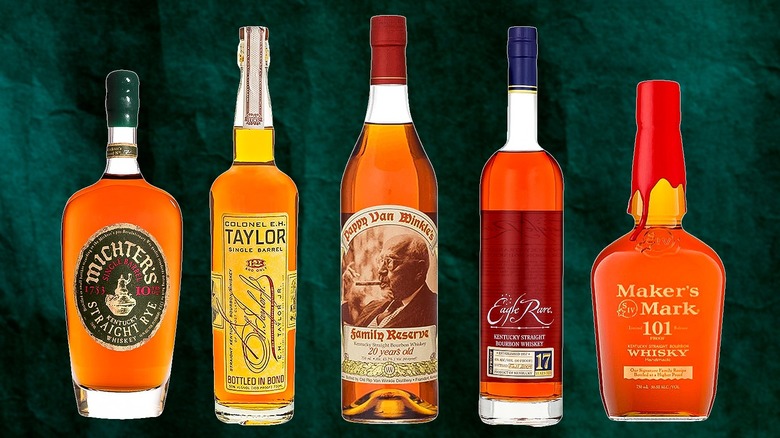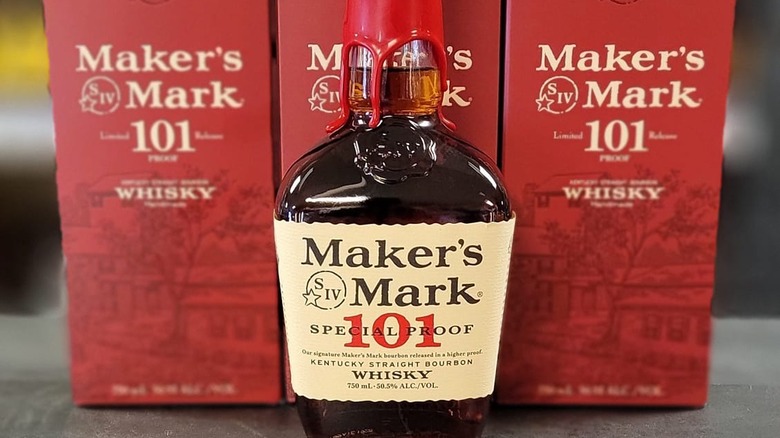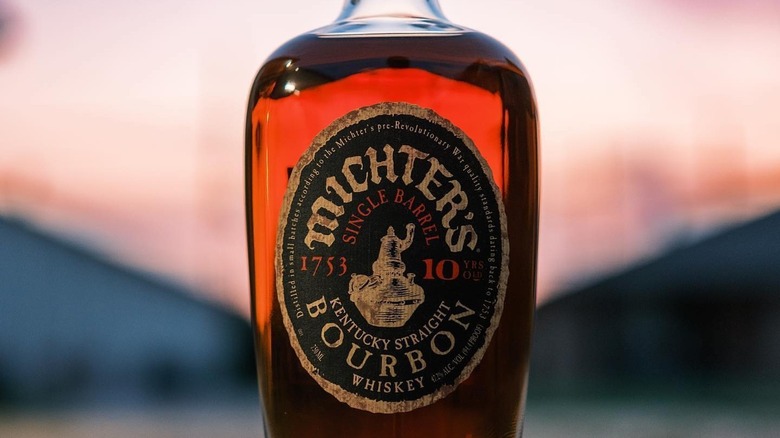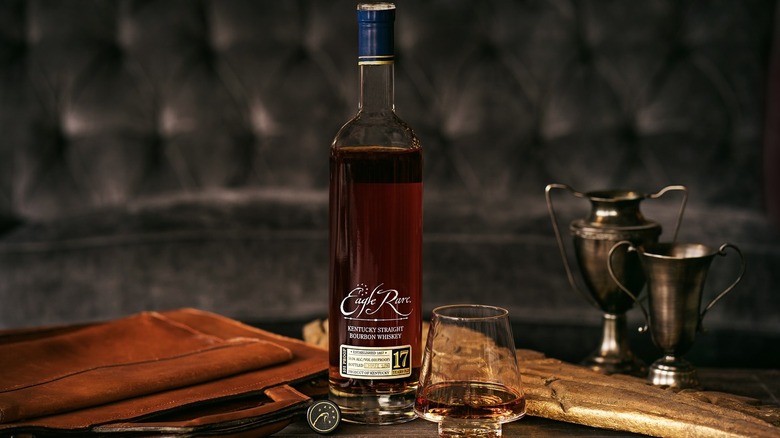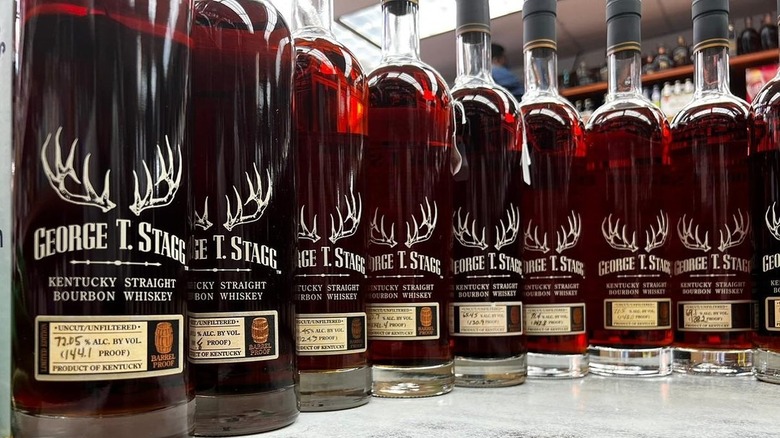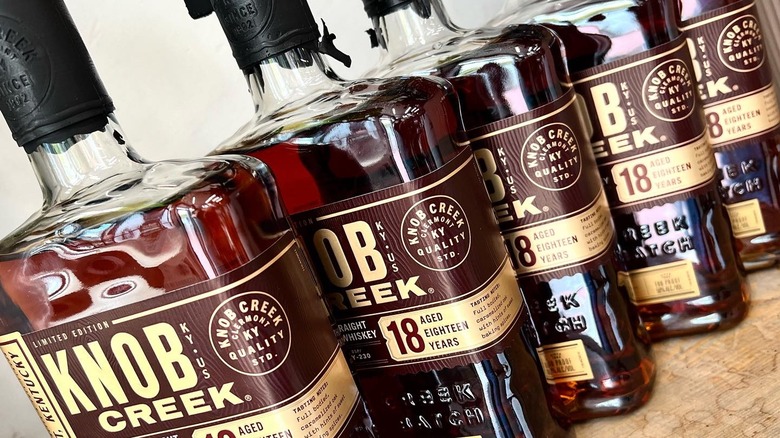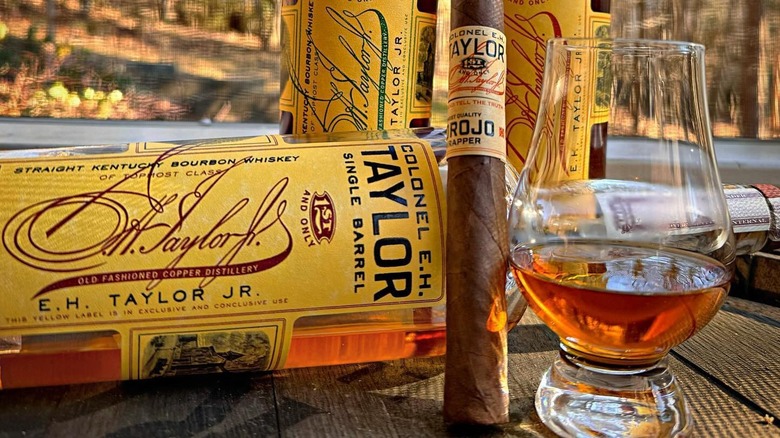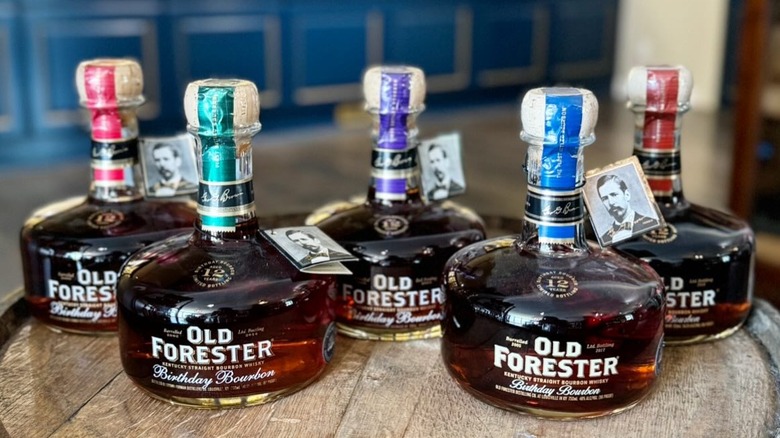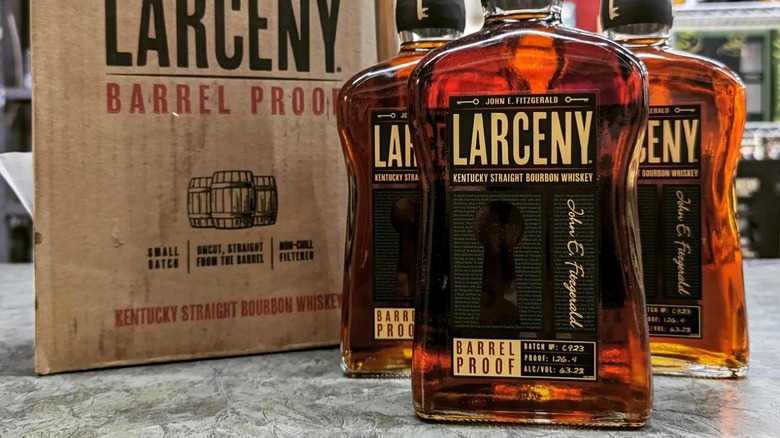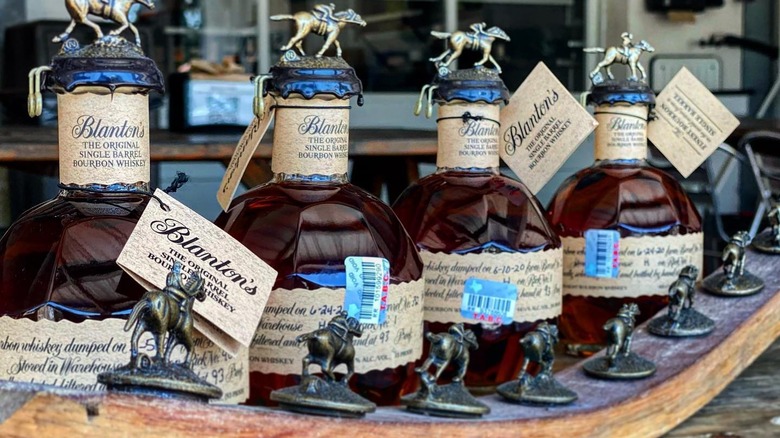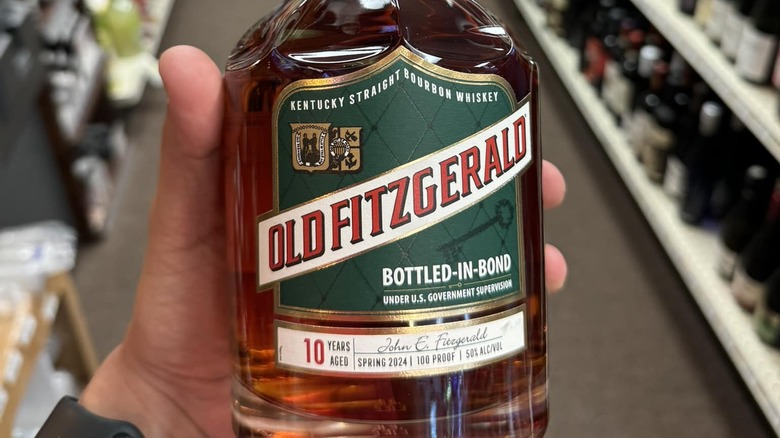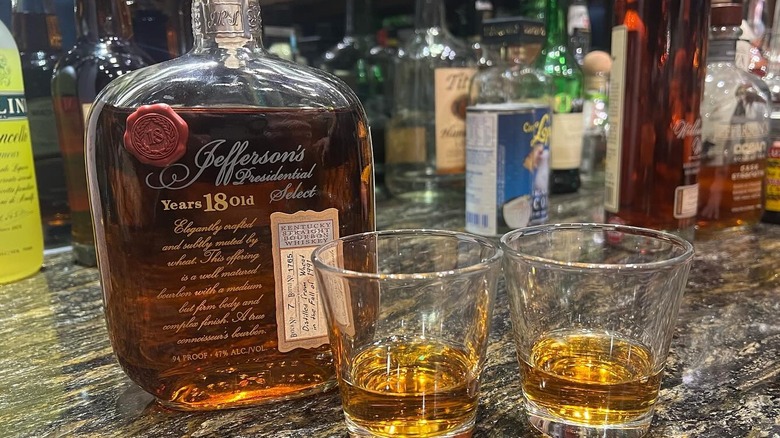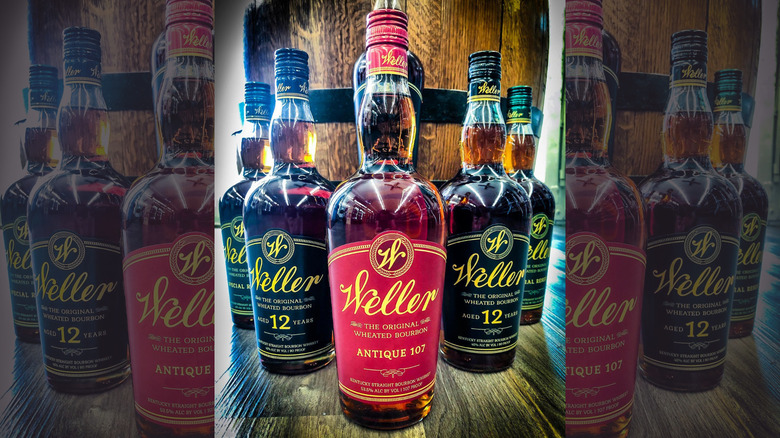12 Bourbon Alternatives To Pappy Van Winkle, According To A Bartender
Whenever a group of dedicated fans exist — regardless of the subject of their passion — there's always a holy grail. In that sense, bourbon lovers are no different. After all, while each whiskey enthusiast has their own tastes and desires, most agree that one bourbon stands above all others: Pappy Van Winkle. Now, there are numerous reasons why this bourbon — named for Julian "Pappy" Van Winkle Sr. – has attained near-mythical status. But for the most part, Pappy's desirability is largely linked to its rarity.
Even if you're lucky enough to locate a bottle of Pappy – a catch-all term commonly used for two associated brands (Pappy Van Winkle and Old Rip Van Winkle) – the price tag is bound to be eye-watering. In fact, as a whiskey fan who's spent most of their career in the bartending industry, I can count the number of times I've seen a bottle of Pappy on two hands ... and can count the number of times I've tried the whiskey on one.
Considering a single serving of Pappy is apt to cost as much as an entire bottle of top-shelf bourbon (when it's even available), most aficionados have accepted that owning a bottle is unlikely. Fortunately, there are plenty of excellent alternatives that should scratch the itch of those looking for a similarly luxurious drinking experience. Here are the 13 best bourbon alternatives to consider instead of Pappy Van Winkle.
Maker's Mark 101
When looking for bourbons that embody the spirit of Pappy, there are a few different factors to consider. Age, price, and exclusivity are all valid, but there's one thing that can't be beaten: the recipe. Now, the idea that a bourbon as ubiquitous and affordable as Maker's Mark can be likened to Pappy might seem far-fetched. But the two whiskeys are more similar than you might think. Julian Van Winkle Sr. himself gave Bill Samuels Sr. – the inventor of Maker's Mark — his initial bourbon recipe, after all, and Maker's Mark 101 makes for a decent alternative to the hard-to-find bourbon.
Maker's Mark 101 is a bit pricier and more exclusive than the standard expressions from the brand. But the high proof gives it a bigger and bolder character that's more aligned with the premium nature of Pappy. Even if it can't match the complexity of Pappy, there's a great barrel character of leather and dried fruits, making it a worthy substitute given its price point.
Additionally, one of the most distinct characteristics of Pappy Van Winkle bourbon is the use of wheat in its mash bill – something shared by Maker's Mark. In fact, Van Winkle Sr. even gifted Samuels Sr. a strain of the yeast used to make his own eponymous bourbon along with his personal blessing. The resulting whiskey boasts a natural smoothness, with a subtle complexity that sets Maker's Mark apart from edgier, rye-forward bourbons.
Michter's 10 Year Single Barrel
Michter's is a whiskey brand that's seen its share of ups and downs. Although it doesn't share the name recognition of distilleries like Buffalo Trace, Heaven Hill, or Stitzel-Weller, one could argue its legacy has the strongest roots in American whiskey. The company that became Michter's was founded in Pennsylvania way back in 1753, and legend has it that George Washington visited the original distillery to procure liquor for his troops during the Revolutionary War. It's gained a reputation worthy of its history in recent decades, and even offers a decent replacement for Pappy when needed.
Part of the reason for this is the distillery only releases single barrel or small batch bourbons, meaning the attention to detail is unparalleled. While single barrel bourbons are somewhat inconsistent by their very nature — and no bottling will taste the same as the last — the quality here never wavers.
Michter's has Pappy's complexity and smoothness, and the sweetness of the oaky, fruity barrel char gives the sense that this bourbon is older than it actually is. Simply put, Michter's 10 Year Single Barrel is a superb Pappy alternative — particularly if you want a bottle that's easy to source and doesn't cost as much as a used car.
Eagle Rare 17 Year
One of the biggest contributions to Pappy's reputation is the incredible amount of time the bourbon is aged. The youngest Pappy Van Winkle bottle spends 10 years maturing in oak barrels, for instance, while the oldest boasts an age statement of 23 years. For Scotch whisky fans, this might not sound that impressive. But you don't often see bourbons this old given the dramatically fluctuating Kentucky climate from summer to winter. It takes no small amount of skill to mature a bourbon for decades while retaining its quality in those conditions; thankfully, the folks behind Eagle Rare 17 Year possess such talents.
A product of the Buffalo Trace distillery, Eagle Rare 17 Year perfectly demonstrates the experience, knowledge, and craftsmanship necessary to develop a mature bourbon on par with Pappy. It boasts complex notes of candied cherry and dried summer fruits that mingle with caramel, vanilla, and rich brown sugar. The bourbon's maturity is unmistakable, with mountains of leathery oak and peppery spice that dominate the drinking experience without overpowering the whiskey's more nuanced tasting notes.
However, it's worth noting that Eagle Rare 17 Year is also an elusive bourbon. While it might not be as tricky to locate as Pappy, you'll still need to put in the work to find this rare bourbon bottle. Plus, if you do luck out, don't be surprised to find a four-figure price tag attached.
George T. Stagg
One of the most important dates in a bourbon collector's calendar is the annual release of Buffalo Trace's Antique Collection. Each year, the distillery distributes a limited number of extra mature, premium bourbons that exemplify its long and storied history. Eagle Rare 17 Year is a regular fixture, but there's another bottle that also makes it to the top of every connoisseur's shopping list: George T. Stagg. Of course, as a true institution of bourbon, it's hardly surprising that George T. Stagg is a worthwhile alternative to Pappy.
Produced as the Buffalo Trace distillery — which was formerly known as the George T. Stagg distillery – this bourbon is only released if it's deemed worthy. In fact, George T. Stagg was actually removed from the 2021 Antique Collection release because it didn't meet the distillery's impeccable standards. Now, the good news is that George T. Stagg returned after 2021, though you shouldn't expect much of a savings compared to a bottle of Pappy.
Either way, if you're fortunate enough to get your hands on George T. Stagg, you'll be met with a bourbon that's more intense than Pappy, yet able to go toe-to-toe in terms of flavor. Splashes of red fruit and baking spice ride the fudgy caramel notes through a remarkably lengthy finish. Although the age of each release varies, every expression is at least 15 years old, with tobacco-rich oak, prickly baking spices, and earthy cocoa showcasing its maturity.
Knob Creek 18
Since Knob Creek was launched in the early 1990s, its various expressions have gone on to collect numerous accolades in the spirits world. Yet folks are often surprised to learn that it uses the same formula as Jim Beam — and even comes from the same distillery. If anything, the fact that Knob Creek 18 can be considered a worthwhile substitute for Pappy is a testament to the impact that extended aging and the small batch method can have on the final bottling.
Knob Creek 18 has the nutty profile that's commonly associated with Beam whiskeys, but it's elevated by touches of dark chocolate, luxurious toffee, and toasted citrus zest. Many whiskeys this old start to lose their fruitiness, but this bourbon still presents plenty of dark fruit, candied cherry, and hints of jammy fig. All of these are wrapped up in incredible amounts of oak character, which features intensely without unbalancing or dominating the rest of the flavors.
Aged for a whopping 18 years, Knob Creek 18 is the oldest whiskey in the Beam lineup, and a limited release bottle, as well. Of course, even if it might set you back a few hundred dollars, you'd be hard pressed to find a bourbon this mature at a similar price. Perhaps Knob Creek tends to be overlooked by those seeking the rarest and most premium bourbons, but it's to their detriment.
E.H. Taylor Jr. Single Barrel
Few names from the annals of American whiskey garner as much respect as Colonel E.H. Taylor. Considered one of the industry's founding fathers, he once owned what's since become the Buffalo Trace distillery. He also had a key role in passing the Bottled-in-Bond Act of 1897– a historic piece of legislation that led to tighter quality controls on bourbon at a time when it was sorely needed. Although E.H. Taylor Jr. Single Barrel is notably more rye-led than Pappy, it boasts a level of craftsmanship and quality that Julian Van Winkle Sr. would be proud of.
Alongside the typical vanilla notes are nuanced flavors of dried fruit, butterscotch, hearty oak, and tongue-tingling rye spice. The mouthfeel is full and creamy, and the finish goes on for what seems like a lifetime. Best of all, this bourbon is an incredibly good value and fairly easy to find. Although prices can fluctuate based on a variety of factors, you'll likely be able to find a bottle for under $100 (depending on location and supply).
Additionally, E.H. Taylor Jr. Single Barrel bourbon bears the "Bottled-in-Bond" label as its namesake intended. This designation indicates the whiskey was produced by a single distillery during a single distillation season, was aged in a government warehouse for at least four years, and was bottled at 100 proof.
Old Forester Birthday Bourbon
Old Forester is another American whiskey that's able to make some impressive claims about its history. It was the first bourbon to be sold in a glass bottle, for example, which helped revolutionize the burgeoning industry. It's also the only bourbon to be sold continuously before, during, and after Prohibition by the same company (thanks to a rare license to produce the spirit for "medicinal purposes"). As for comparable bottles to Pappy, its small batch Birthday Bourbon bottles — which have been released annually since 2000 to celebrate its founder's birthday — are an excellent pick.
Each year's barrel is hand-selected by the master distiller and master taster. The bottling varies in terms of taste from year to year as expected — given the nature of the annual release — and you'll find the prices can vary widely. However, Old Forester aims for consistency, and the average age of the whiskey in each Birthday Bourbon bottle is 12 years.
On the whole, the Birthday Bourbons are smooth, complex, and well-balanced. Common tasting notes are sugary buttercream, roasted caramel, and elements of candied tropical fruit. Additionally, the oakiness is mature and bold, presenting itself from the first sniff to the lingering finish. In short, Old Forester Birthday Bourbon is ideal for anyone seeking a collector's bourbon that won't break the bank.
Larceny Barrel Proof
It should come as no surprise that the landscape of the bourbon industry has changed dramatically in the centuries since its invention. Distilleries have switched hands, smaller brands have been absorbed by conglomerates, and recipes have been reformulated. However, the bourbon family tree is well-documented, so it's easy to find where roots have intertwined over the years. Take Larceny, for example. Produced by Heaven Hill, it's named in honor of a U.S. treasury agent, John E. Fitzgerald, who had a penchant for pilfering bourbon from the warehouses under his watch.
However, Larceny was inspired by an even older brand, Old Fitzgerald, which Heaven Hill purchased from Stitzel-Weller ... a distillery that was the one-time workplace of Julian Van Winkle Sr. himself. Aside from this shared heritage, Larceny is a wheated bourbon, as well, so its flavor profile isn't that dissimilar from Pappy bourbon. Soft and sweet, the barrel proof nature of this whiskey means it's not cut with water before bottling. This gives Larceny Barrel Proof a rich and punchy flavor that's dripping with caramel and molasses, with a toasty barrel character that makes it taste mature beyond its years.
Blanton's Single Barrel
The name Albert Bacon Blanton commands as much respect in the bourbon world as any other, and it's easy to see why. For starters, Blanton began working as an office boy for the George T. Stagg distillery at age 16 before the company was rechristened as Buffalo Trace. Eventually, Blanton worked his way to the role of company president, and became famous for his construction of the company's iconic Warehouse H barrel-aging facility. To this day, Warehouse H produces Blanton's Single Barrel bourbon, which is a respectable alternative to Pappy.
This highly sought-after collector's whiskey is instantly recognizable thanks to its unique, orb-shaped bottle and racehorse-adorned cork stopper. Of course, the delicious, amber-hued liquid within each eye-catching vessel is just as impressive as its vessel. While it doesn't have the wheated profile of Pappy, Blanton's Single Barrel is extremely consistent in offering drinkers a powerfully flavorful experience.
Additionally, this full-bodied bourbon offers everything you'd expect from such a highly-regarded whiskey, such as lashings of sweet vanilla and smooth caramel, bold but balanced spice, and a deep oak character. Despite its stellar reputation, Blanton's Single Barrel is also remarkably affordable, and one could argue that it's even better value than a bottle of Pappy ounce-for-ounce.
Old Fitzgerald 10 Year Bottled-in-Bond
As I mentioned above, Old Fitzgerald was produced by the Stitzel-Weller distillery back when Julian "Pappy" Van Winkle Sr. was still running the show. More than that, the brand once sat alongside Old Rip Van Winkle bourbon in the distillery's range. Although the whiskeys are distinct, they both share the hallmarks of Stitzel-Weller's wheat-forward recipe — which is why you should consider Old Fitzgerald 10 Year Bottled-In-Bond when searching for a Pappy replacement.
While there are older and rarer expressions of Old Fitzgerald that command similar prices to Pappy, the 10 Year Bottled-in-Bond is an excellent compromise. It has the characteristic smoothness of a wheated bourbon that showcases the silky notes of butterscotch, vanilla cream, and peanut butter. There's a mellow fruit profile with touches of baking spices — cinnamon, nutmeg, and clove — and an inviting oak presence.
Now, if you don't mind shelling out big bucks for a more mature expression, you can find something that's a lot closer to genuine Pappy from Old Fitzgerald. Ultimately, it comes down to whether you want an affordable bourbon that gives you a sense of the essence of Pappy, or if you have no qualms about splashing out for a collector's whiskey that's considered an actual substitute.
Jefferson's Presidential Select
Jefferson's takes a modern approach to whiskey-making, pursuing greatness through experimentation and innovation rather than relying solely on centuries-old production methods. That's not to say it has no ties whatsoever to bourbon history; in fact, the founder's 8th-generation grandmother, Marian McClain, was arrested in 1799 for bootlegging. Plus, the distillery's earthy, oaky, and beautifully balanced whiskeys match the quality of Pappy — in part because they contain the last of the distillate from the company built and run by Julian Van Winkle Sr. himself.
Consisting of bourbon sourced from the last remaining stocks of the now-defunct Stiztel-Weller distillery, the first expressions released by Jefferson's during the early 2010s are the most revered. Now, the limited releases of Jefferson's Presidential Select may be a thing of the past (at least as of August 2024). But it's still possible to obtain a bottle if you have the resources and financial means to do so when searching for a Pappy alternative. In short, Jefferson's deserves a lot of credit for producing excellent whiskey despite lacking the lengthy heritage of its many competitors.
W.L. Weller 12 Year & Old Weller Antique
It wouldn't be an exaggeration to say that without W.L. Weller, we wouldn't have Pappy Van Winkle bourbon. After all, Julian Van Winkle Sr. began his career as a whiskey salesman for W.L. Weller and Sons, and it was William Larue Weller who popularized the use of wheat instead of rye to bulk up bourbon's mash bill (the technique that gives Pappy bourbons their iconic flavor profile). Weller bourbons always come up when people discuss Pappy alternatives, so it's only fitting that I include it here.
Both bourbon brands are now made by Buffalo Trace, and it's something of an open secret that they use the same base recipe, stills, barrels, and aging houses. While this breeds striking similarities, the final products still vary, and you'll find differing opinions on which W.L. Weller expression is the best like-for-like substitute. Perhaps this explains why some adventurous connoisseurs have realized the best Pappy substitute doesn't sit within a single bottle — but two.
Affectionately known as "Poor Man's Pappy," this do-it-yourself concoction involves combining W.L. Weller 12 Year and Old Weller Antique 107, and letting the homemade blend sit for a few weeks. Marrying the mature qualities of Weller 12 with the more youthful, higher proof Antique 107 produces a bourbon that's more than the sum of its parts. The mouthfeel is thick with vanilla, sweet tobacco, and chewy caramel, with all the oaky barrel character a Pappy fan could hope for.
